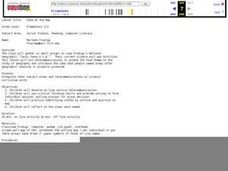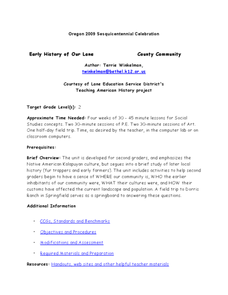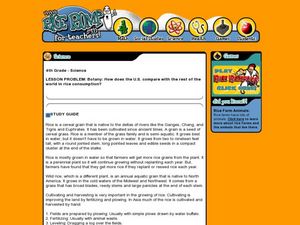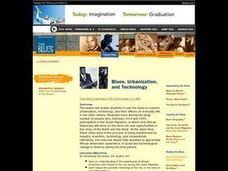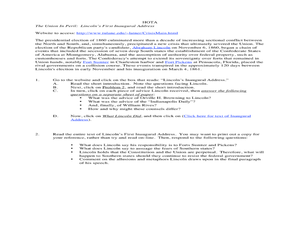Curated OER
PRIMARY AND SECONDARY SUCCESSION IN AMERICA'S FORESTS
Students examine forest organisms, features of some of the different types of forest, classify organisms based on the type of forest they come from, and explore how certain species are connected with other, particular species within...
Curated OER
Discovering Fall
Young scholars explore the American landscape during fall. After viewing paintings of fall, learners imagine themselves there and what it would be like. They then build an understanding of the painter's use of detail and color before...
Curated OER
The Mussels Are Coming
Students work together to identify and describe the various types of mussels. Using a color-coded system, they plot the arrival date of zebra mussels in North American waters. They discuss the increase in their population with the class.
Curated OER
Did You Know...
Pupils research about hispanic history. They complete a true-false worksheet together or in groups. They discover achievements by hispanic members of society.
Curated OER
We're All Passenger
Students examine Passenger Pigeons and why they are now extinct. Through a class discussion, students discover the need to help endangered animals. They consider activities to become involved in assisting animals. Students write a poem...
Curated OER
Food on the Map
Learners work together to examine the tastiest towns in the United States. After discovering the names of the equipment, they identify the seven continents. They take a survey and locate the cities and states of the foods mentioned.
Curated OER
Early Native Americans
Fourth graders locate on a globe where the land bridge was. They describe the progression of nomadic people into North America.
National Endowment for the Humanities
Kennewick Man: Science and Sacred Rights
"Have respect for the dead!" Scholars investigate how science and religion often clash. As they look into the laws of science and the laws of religion, the legal ramifications at the federal level of both play into an argument they...
Curated OER
I Wonder Where The Manduca Came From...
Students examine how the Manduca came to America the economic means that made it possible. They discover what frass is and make observations. They make their own speculations on why the Manduca came to America.
Curated OER
Why Not Come to North Amercia?
Students examine the motives for French expansion into the New World, they evaluate primary source documents to determine who, what, when, where and why.
Curated OER
Discovering the Local Community
Third graders create a mini-atlas of the human and physical characteristics of their local community, which includes landforms, climate, vegetation, population, and economics. They use nonfiction map-related resources to obtain ...
Curated OER
Be a Food Explorer
Young scholars discover the origins of fruits and vegetables. In this nutrition lesson, students research how fruits and vegetables came to the United States via trade routes. Resources are provided.
Curated OER
George Washington and Slavery: The 1799 Census of Slaves
Learners discover details about the slave community at Mt. Vernon. For this George Washington lesson, students examine Washington's 1799 Slave Census in order to determine what life was like for slaves of the first president. An analysis...
Curated OER
Early History of Our Lane
Second graders study Native American Kalapuya culture. In this American History lesson, 2nd graders discover the early inhabitants of their community. They take a field trip to Dorris Ranch.
Curated OER
Rice Consumption
Fourth graders discover facts about rice and how it is farmed. In this rice research lesson, 4th graders investigate how much rice is eaten in the United States compared to other countries. Students research countries and graph the...
Curated OER
Mexico Outline Map 2
In this outline map worksheet, students discover and investigate the North American country of Mexico. This blank outline map may be used for a variety of classroom activities.
Curated OER
Social Studies, Music, The Blues, Urbanization, and Technology
Enable students to use the blues to explore urbanization, technology, and their effects on everyday life in the 20th century. Musicians were among the large number of people who, between 1914 and 1945, participated in the Great Migration...
Curated OER
“Will I or Won’t I?” Colonel Robert Gould Shaw, 54th Massachusetts Regiment
Students discover the story of the 54th Massachusetts Regiment. In this American Civil War lesson, students study the life of Robert Gould Shaw and the regiment he led. Students research primary and secondary sources to learn about the...
Curated OER
Ship of the Line
Students discover boats by researching 18th century ships. In this Naval history lesson, students identify and describe the different components of an 18th century naval ship after researching information on the Internet. Students...
Curated OER
Mexico: One Land, Many Cultures
Students, through a variety of activities, discover the geography and culture of Mexico. They make maps, read folktales, write a journal, create pinatas and other artistic pieces, and review the history of Mexico.
Curated OER
The Union In Peril: Lincoln’s First Inaugural Address
In this research skills worksheet, students research the noted website to discover details about Lincoln's Inaugural Address and then respond to the provided analysis questions.
Curated OER
World Map and Globe - Lesson 15 (K-3)
Students discover mountain ranges and their locations in the world. In this physical map lesson, students locate and identify major mountain ranges of the world on a large physical map.
Curated OER
From One Seed Grow Many Seeds
First graders practice identifying plants by singing a song. In this plant life instructional activity, 1st graders sing the song "Parts of a Plant" which is based on the anatomy of sunflowers. Students discover agriculture techniques...
Curated OER
Ice Age Challenge Game
Students use a website to do various projects about the ice age and discover the route taken by the first arrivals are unknown and are the subject of a great deal of debate and research.







